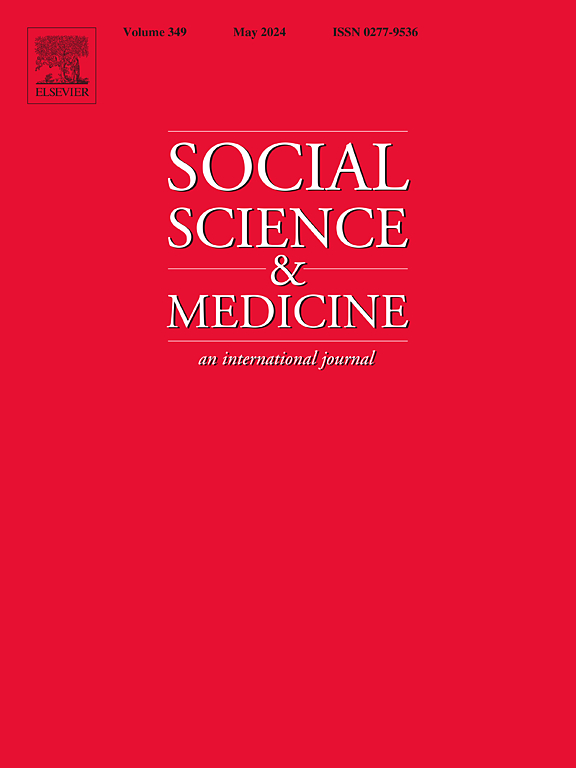成年后吸食大麻:德克萨斯州不同人群吸食大麻阶段之间的过渡特征。
IF 4.9
2区 医学
Q1 PUBLIC, ENVIRONMENTAL & OCCUPATIONAL HEALTH
引用次数: 0
摘要
目的通过对 2019 年春季至 2021 年秋季期间观察到的不同青年和年轻成年人队列中的社会人口和其他风险因素,描述和比较吸食大麻(THC)的过渡情况:我们通过德克萨斯州青少年烟草和营销监测(TATAMS)系统分析了六(6)波面板数据,这些数据来自 2605 名过渡到青年期的青少年;参与者提供了 N = 13,974 个观察结果(即完成的调查问卷)。TATAMS 样本中有 37.7% 的西班牙裔、31.7% 的新罕布什尔-白人、14.5% 的新罕布什尔-黑人和 16.1% 的新罕布什尔-其他族裔。我们采用了一个三态马尔可夫模型来估算吸食大麻的起始时间(从不→曾经)、尝试时间(从不→现在)、升级时间(曾经→现在)和降级时间(现在→曾经)。首先,我们以非西班牙裔(NH)黑人为参照,比较了不同种族/族裔吸食四氢大麻酚的转变情况。其次,我们按种族/族裔对马尔可夫模型进行了分层,以确定吸食大麻转变的共同和独特预测因素,并研究了每个种族/族裔类别在性别、年龄、酒精使用、抑郁(PHQ-9)、焦虑(GAD-7)和尼古丁吸食等方面的差异:基线时,72.7%的人从未吸食过大麻,12.7%的人曾经吸食过大麻,14.5%的人目前正在吸食大麻。在三年中,相对于西班牙裔(aHR:1.89)、新罕布什尔州-白人(aHR:2.27)和新罕布什尔州-其他族裔(aHR:2.01),新罕布什尔州-黑人尝试吸食大麻的风险(从未吸食→目前吸食)明显更高。分层模型显示,在新罕布什尔州-白人(aHR:5.08)、西班牙裔(aHR:2.32)和新罕布什尔州-黑人(aHR:2.91)参与者中,当前饮酒是大麻吸食实验的常见预测因素。抑郁预示着西班牙裔开始吸食大麻(aHR:1.75),预示着新罕布什尔州黑人开始尝试吸食大麻(aHR:3.95):结论:相对于其他种族/族裔类别,在青年和青年期开始吸食大麻的情况在北卡罗来纳州黑人青年中最为常见。酒精是不同种族/族裔吸食大麻的常见预测因素,而抑郁症仅与西班牙裔和新罕布什尔州黑人青少年吸食大麻的转变有关。未来的研究应该调查年轻人中酗酒、心理健康和吸食大麻之间的联系。本文章由计算机程序翻译,如有差异,请以英文原文为准。
Cannabis vaping use in emerging adulthood: Characterizing transitions between stages of vaping among a diverse cohort in Texas
Objective
To characterize and compare transitions in cannabis (THC) vaping by sociodemographic and other risk factors among a diverse cohort of youth and young adults observed between Spring 2019 and Fall 2021.
Methods
We analyzed six (6) waves of panel data from n = 2605 youth transitioning into young adulthood via the Texas Adolescent Tobacco and Marketing Surveillance (TATAMS) system; participants provided N = 13,974 observations (i.e., completed surveys). The TATAMS sample was 37.7% Hispanic, 31.7% NH-White, 14.5% NH-Black, and 16.1% among NH-Other. We applied a three-state Markov model to estimate cannabis vaping initiation (never→ever), experimentation (never→current), escalation (ever→current), and de-escalation (current→ever). First, we compared transitions in THC vaping by race/ethnicity, with non-Hispanic (NH) Black as the referent. Second, we stratified the Markov models by race/ethnicity to identify common and unique predictors of cannabis vaping transitions, examining differences by: sex, age, alcohol use, depression (PHQ-9), anxiety (GAD-7) and nicotine vaping, across each race/ethnic category.
Results
At baseline, 72.7% never vaped cannabis, 12.7% ever vaped cannabis, and 14.5% currently vaped cannabis. Across three years, risk for cannabis vaping experimentation (never → current) was significantly greater among NH-Blacks, relative to Hispanics (aHR: 1.89), NH-Whites (aHR: 2.27), and NH-Other (aHR: 2.01). Stratified models showed that current alcohol use was a common predictor of cannabis vaping experimentation among NH-White (aHR: 5.08), Hispanic (aHR: 2.32), and NH-Black (aHR: 2.91) participants. Depression predicted cannabis vaping initiation among Hispanics (aHR: 1.75) and experimentation among NH-Blacks (aHR: 3.95).
Conclusions
Onset of cannabis vaping during youth and young adulthood was most common among NH-Black youth, relative to other race/ethnic categories. Alcohol was a common predictor of cannabis vaping across race/ethnic categories while depression was linked to cannabis vaping transitions among Hispanic and NH-Black youth, only. Future research should investigate the link between alcohol use, mental health, and cannabis vaping among young people.
求助全文
通过发布文献求助,成功后即可免费获取论文全文。
去求助
来源期刊

Social Science & Medicine
PUBLIC, ENVIRONMENTAL & OCCUPATIONAL HEALTH-
CiteScore
9.10
自引率
5.60%
发文量
762
审稿时长
38 days
期刊介绍:
Social Science & Medicine provides an international and interdisciplinary forum for the dissemination of social science research on health. We publish original research articles (both empirical and theoretical), reviews, position papers and commentaries on health issues, to inform current research, policy and practice in all areas of common interest to social scientists, health practitioners, and policy makers. The journal publishes material relevant to any aspect of health from a wide range of social science disciplines (anthropology, economics, epidemiology, geography, policy, psychology, and sociology), and material relevant to the social sciences from any of the professions concerned with physical and mental health, health care, clinical practice, and health policy and organization. We encourage material which is of general interest to an international readership.
 求助内容:
求助内容: 应助结果提醒方式:
应助结果提醒方式:


